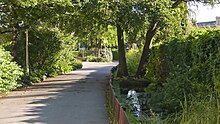Wettsteinpark
The Wettstein Park is a park in the 2nd Viennese district Leopoldstadt . It is a linear park between the Danube Canal and Obere Donaustraße and extends roughly from Siemens-Nixdorf-Steg to Rossauer Bridge . It is named after the Austrian botanist Richard Wettstein .
history
In the 18th century, the Danube Canal, which at that time was a branch of the unregulated Danube , reached in this area as far as today's Obere Donaustraße. By regulating the canal, an area was created here that was used as a wood and later stone deposit from the 19th century. From 1886 there was a steam tramway station at the southern end of the area, approximately at the level of the Rossauer Bridge , which was only built in 1983 , which served as the central departure point towards Stammersdorf from 1901 . From 1903 to 1933 in this area (north of the Augarten Bridge from 1873), the Schanzlmarkt was located , which had to be relocated from its original location on the right bank of the Danube Canal in the course of the construction of the Danube Canal line of the light rail . A park was created here from 1929 to 1930. It was named after Richard Wettstein, professor of botany at the University of Vienna and director of the Botanical Gardens , in 1931. In the course of structural changes in the immediate vicinity (expansion of the Upper Donaustraße, construction of the Siemens-Nixdorf-Steg), there were extensions in 1985 and 1989 Redesign of the park.
layout
The center of the 30,000 m² park, which is around 80 m wide at its widest point, is a round square, in the middle of which the artificial stone sculpture of seated and reclining people , created by the sculptor Hilde Uray , has been located since 1956 . Originally, the bronze sculpture Ruf der Jugend by Felix Weiss stood on the natural stone plinth from 1931 onwards ; it was dismantled in 1938 after the " Anschluss of Austria " in the course of an anti-Semitic "de-trading of the Viennese cityscape" for which Wilhelm Frass was responsible for sculpture in the Vienna Cultural Office and melted down. The part of the round square located on Obere Donaustraße is closed off by a semicircular cast stone pergola with wooden supports. At the southern end of the park, in a fenced, publicly inaccessible area, there are buildings and premises of the Vienna City Garden Authority. A small, fenced-in children's playground is located between this area of the City Garden Authority and the round square. A cycle path runs along Obere Donaustraße, on the bank side is the Anton-Schmid-Promenade, between which and the bank of the Danube Canal there is a strip of embankment. The main path extends centrally along the longitudinal axis of the park. The park's trees include Norway maple , hybrid plane and pyramid poplar .
Rosarium
In 1934, a rosarium was created around the central sculpture in the park's round square . This was newly laid out in 1996 and gathered 317 different types of roses on an area of 1300 m² . The oldest variety was the climbing rose Alberic Barbier, bred in 1900 . In 2015, a three-year general renovation of the rosarium began, in which the rose bushes are to be replaced by dog roses and other flowers, trees and bushes are cut back and the pergola is renewed or repaired. The removal of the rose bushes was controversial in terms of district politics.
literature
- Eva Berger: Historic Gardens of Austria. Gardens and parks from the Renaissance to around 1930. Volume 3. Böhlau, Vienna 2004, ISBN 978-3-205-99477-0 , Volume 3, pp. 106-107.
Web links
Individual evidence
- ^ City of Vienna: Wien Kulturgut , General City Plan 1912 .
- ^ Peter Payer: The Vienna Danube Canal. Everyday cultural significance and image change 1800–2010
- ^ Historical review of the correspondence from the town hall from May 1964
- ↑ Artificial stone sculpture "Seated and Reclining", work of art in public space
- ↑ Susanne Panholzer-Hehenberger: The image of man in sculpture in Austria between 1938 and 1945. Diploma thesis University of Vienna, Vienna 2008, p. 22 ( online version )
- ↑ Rosarium Wettsteinpark, according to MA42 notification
- ↑ For VP-Hefelle, work on the Danube Canal raises questions , OTS broadcast from May 4, 2015
Coordinates: 48 ° 13 ′ 20.7 " N , 16 ° 22 ′ 7.9" E



